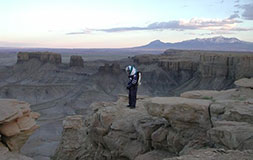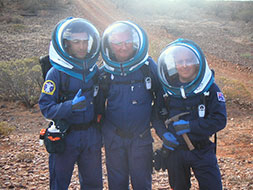Main menu
MarsSkin 3
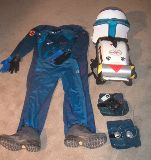 Expedition 2, held at Arkaroola in
South Australia's
Flinders Rangers (and the future site of MARS-Oz), was the first deployment of MarsSkin 3. This version included
significant improvements over the previous suits. The helmet was changed to a more traditional bubble type, as the
flexible gas-pressurised neck supports for the 'motorbike' type helmet of MarsSkin 2 would not be possible.
This helmet was fitted with a ventilation system, drink bottle bite valve (with drink bladder in the backpack) and a
VOX radio earplug. The backpacks are from Boblbee and feature a rigid external shell for protection of the life
support system internals. The volume of the pack is approximately equal to that of a real MCP suit, and represents a
significant reduction in bulk and weight over gas-pressurised backpacks. This backpack is more visually appealing and
realistic than the existing scuba backplate of MarsSkin 2.
Expedition 2, held at Arkaroola in
South Australia's
Flinders Rangers (and the future site of MARS-Oz), was the first deployment of MarsSkin 3. This version included
significant improvements over the previous suits. The helmet was changed to a more traditional bubble type, as the
flexible gas-pressurised neck supports for the 'motorbike' type helmet of MarsSkin 2 would not be possible.
This helmet was fitted with a ventilation system, drink bottle bite valve (with drink bladder in the backpack) and a
VOX radio earplug. The backpacks are from Boblbee and feature a rigid external shell for protection of the life
support system internals. The volume of the pack is approximately equal to that of a real MCP suit, and represents a
significant reduction in bulk and weight over gas-pressurised backpacks. This backpack is more visually appealing and
realistic than the existing scuba backplate of MarsSkin 2.
The most important improvement, however, is the Skins simulation MCP layer for use under the outer layer. These Skins simulate the compression of a real MCP garment in the low pressure environment of Mars. The Skins are a poly-lycra coolmax material with sublimation printing, and wick perspiration and heat. In addition, the helmet frames are covered with the same skins material. Our thanks to Brad Duffy for his help with all the Skins input.
The MarsSkin Team conducted three sets of testing during Expedition Two to Arkaroola in outback South Australia. The three tests were:
- Analogue Glove studies
- Field of View tests of Helmets
- Field tests of MarsSkin V3
The analogue glove studies were conducted in conjunction with participants from the International Space University Summer Session Program 2004, and students from the University of Technology Sydney. The tests compared analogue gas-pressurised suit gloves with the analogue MCP alternative, and the naked hand. A series of realistic, repeatable tasks was designed by students from UTS. These included sample bagging, an engineering task, and using a Brunton (a common geologist's tool). Thirty subjects were involved in the test, and found that MCP gloves increase EVA task time by only 65% compared to the naked hand, instead of 232-500% for gas-pressurized gloves.
A test report is available here.
 The Field of View study
investigated the
impact that different suit helmet styles have on astronaut visibility. This was a pilot study, to be expanded in a
later trial at MDRS (Mona Lisa Crew 40). The test compared the subject's normal visual range (head still and head
movement allowed respectively) with the range of vision possible inside the MarsSkin V2 helmet and the MarsSkin V3
helmet. The MarsSkin V2 helmet was a motorbike style helmet which moved with the subject's head. The helmet for
V3 was a 'bubble' helmet fixed to the subject's shoulders. Vertical visual range (lowest point visible,
highest point visible) was measured using a long ruler placed at successive 45degree intervals around the
subject's body. The enabled the visual range to be plotted in 2-D. The study found that while the V2 helmet
provides good forward vision no matter where the astronaut is looking, the V3 helmet has far better peripheral
vision, which is critical for driving a rover in particular. Several improvements to the V3 helmet design were also
identified through this study. This test needs to be repeated with more subjects to remove the effect of differences
in individual natural visual range.
The Field of View study
investigated the
impact that different suit helmet styles have on astronaut visibility. This was a pilot study, to be expanded in a
later trial at MDRS (Mona Lisa Crew 40). The test compared the subject's normal visual range (head still and head
movement allowed respectively) with the range of vision possible inside the MarsSkin V2 helmet and the MarsSkin V3
helmet. The MarsSkin V2 helmet was a motorbike style helmet which moved with the subject's head. The helmet for
V3 was a 'bubble' helmet fixed to the subject's shoulders. Vertical visual range (lowest point visible,
highest point visible) was measured using a long ruler placed at successive 45degree intervals around the
subject's body. The enabled the visual range to be plotted in 2-D. The study found that while the V2 helmet
provides good forward vision no matter where the astronaut is looking, the V3 helmet has far better peripheral
vision, which is critical for driving a rover in particular. Several improvements to the V3 helmet design were also
identified through this study. This test needs to be repeated with more subjects to remove the effect of differences
in individual natural visual range.
The preliminary test report is available here.
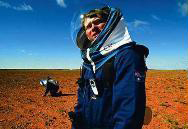
Finally, the first field tests of MarsSkin V3 were conducted at Expedition 2. This included the first trial of the new Skins inner layer and the V3 helmet design. Test participants were asked to complete a detailed survey of the suit performance after a long EVA. These responses were collated for future suit improvements.
Mona Lisa & Leonardo Expeditions
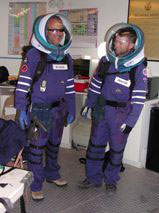
The purpose of the most recent MarsSkin study was to
conduct a comparison between the spacesuits at the Mars Desert Research Station (MDRS) in Utah and the MarsSkin 3
suits. The US MDRS spacesuits simulate gas-pressurisation (as currently used by astronauts), and the MarsSkins
simulate mechanical counter pressure (MCP). MCP suits utilize a form-fitting garment underlay to physically compress
the astronaut, rather than pressurise him/her with a gas. This approach is an alternative technology that may help to
solve the continuing drawbacks of gas suits, such as rigidity, mass, bulk, oxygen leakage, safety, durability, and
expensive maintenance, and is particularly suited for Martian exploration. The MarsSkins were available for use by the
Leonardo and Mona Lisa crews at MDRS via crewmembers James Waldie and Natalie Cutler for a total of 4 weeks. For more
information and images of the Leonardo and Mona Lisa missions, please see http://monalisaleonardo.isunet.edu
The MarsSkin suits (see image above right) were setup and deployed after 1 week of baseline testing with the MDRS
suits, except for the first 2 days when a Beyond Tomorrow TV crew filmed both types of suits (to be aired June 22).
After MarsSkin deployment with the crew, it soon became clear that the ventilation system batteries were performing
poorly, despite full recharges. Further, there were compatibility problems with the MarsSkin and MDRS radios, and the
VOX operation (required by the helmets) were set off by the ATV engines. It was decided that the best way forward was
to use the MDRS backpacks/helmets with the MarsSkin suits, as this solved the ventilation and radio issues but did not
significantly impact on the flexibility advantages that MCP garments should confer. All the crewmembers wore both suit
types during a variety of EVA tasks (such as the CRV, thermal insulation maintenance, geology sampling, exploration
etc), and then filled in a lengthy survey about the attributes of each aspect of the suit design and performance
(comfort of the suit, ability to walk/crouch, usefulness of the pockets, etc). All crewmembers commented that
MarsSkin was much more comfortable to wear, with far greater levels of reach and dexterity, and lower levels of
fatigue. The suits were particularly beneficial in the hot weather, when perspiration was 'wicked' through
the MCP garments.
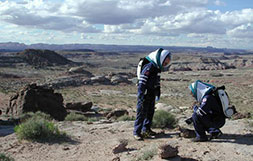
Glove flexibility is noted as a critical item of suit design because of the difficulty in engineering a garment for
the complex joints of the hand/fingers, and due to the importance of hand function in all EVA tasks. To give some
insight into the impact of glove design, the MDRS suits were also worn with just the MarsSkin gloves. This hybrid
suit was then graded by the subject according to the standard survey sheet. If the results of the hybrid are close to
that of the full MCP suit, this gives reason to concentrate MCP development on just the gloves, rather than a full
body suit.
Another comparative experiment was conducted on the helmets' field of view. The test was to see how much the
different types of helmets reduce the astronaut's visual range. Using a calibrated rod that was moved around the
test subject, the investigation measured how far back, up, and down the subject could see without a helmet, with a
MarsSkin helmet and with a MDRS helmet. The results of the studies will be published in an upcoming volume of the
American Astronautical Society Science and Technology Series, the Mars Society Advanced Suits Symposium, and the 5th
Australian Space Science Conference (among others).
James Waldie
MarsSkin Project Manager
